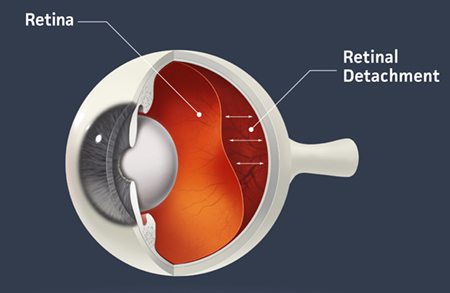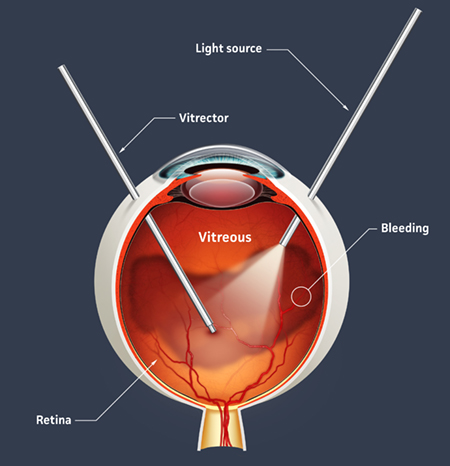Retinal Detachment Treatment is a medical procedure designed to repair a detached retina. Retinal detachment occurs when the thin layer of tissue that lines the inside of the eye (the Retina) becomes separated from its underlying supportive tissues within the eye. This can cause permanent vision loss if not treated quickly. Retinal Detachment Treatment can involve a number of surgical techniques, including laser surgery, cryotherapy (freezing), and vitrectomy.
Retinal Detachment Treatment is Suggested to Avoid Visual Disturbances

Retinal Detachment Treatment is typically recommended when a Retinal Detachment has been identified as causing vision disturbances or other visual symptoms. A Retinal Detachment can be caused by several factors, including aging, trauma to the eye, infection, high levels of nearsightedness, or fluid buildup in the eye.
The retina is the layer of tissue at the back of your eye that senses light and sends images to your brain. When the retina detaches from the back of the eye, it is known as retinal detachment. This can happen if there is a tear or hole in the retina, or if the retina pulls away from its supporting tissues. A retinal detachment can be caused by several factors, including aging, trauma to the eye, infection, high levels of nearsightedness, or fluid buildup in the eye. Symptoms of a retinal detachment include floaters, flashes of light, blurred vision, or a shadow in your peripheral vision. If you experience any of these symptoms, you should see an eye doctor immediately. Treatment for retinal detachment includes surgery to reattach the retina to the back of the eye.
Causes of Retinal Detachment
Aging
As we age, our risk for developing a detached retina increases. This is because the vitreous—the jelly-like substance that fills the middle of your eye—begins to shrink and pull away from the retina as we get older. This process is known as vitreous detachment, and it can cause tiny tears in the retina. If these tears are not treated promptly, they can lead to retinal detachment.
Trauma to the Eye
A direct blow to the eye can cause blunt trauma that leads to retinal detachment. This type of injury usually occurs during contact sports or car accidents. penetrating trauma—such as being stabbed in the eye with a foreign object—can also cause retinal detachment.
Infection
Certain types of infections can lead to inflammation inside the eye, which can put pressure on the retina and cause it to detach. One example of an infection that can cause retinal detachments is endophthalmitis, which is an infection of the internal structures of the eye. This condition usually occurs after surgery on the eye but can also develop spontaneously. Symptoms include pain, redness, and decreased vision. If you experience these symptoms, you should see an ophthalmologist immediately.
Retinal Detachment Treatment is designed to reattach the Retina to its original supportive tissues and can help restore vision loss caused by Retinal Detachment. It is important to seek Retinal Detachment Treatment as soon as possible once Retinal Detachment has been identified, as delaying treatment may cause further damage to the Retina and lead to permanent vision loss.
Retinal Detachment Treatment is Successful

Retinal Detachment Treatment is typically successful in restoring vision, but it may take some time depending on the severity of Retinal Detachment. If Retinal Detachment has caused significant damage to the Retina, Retinal Detachment Treatment may be unsuccessful or require more extensive treatments such as vitrectomy. Retinal Detachment Treatment is an important procedure designed to save and restore vision, so it is important to seek Retinal Detachment Treatment as soon as possible if Retinal Detachment has been identified.
Retinal Detachment Treatment is successful when completed as soon as possible after Retinal Detachment has been identified and can help restore vision. It is important to take preventive measures to help avoid Retinal Detachment in the first place, such as wearing protective eyewear and regularly visiting an ophthalmologist. Retinal Detachment Treatment is a medical procedure designed to help save and restore vision, so speak to your eye care provider today to learn more about Retinal Detachment Treatment options.
Preventative Measures To Avoid Retinal Detachment
It is also important to take preventive measures to help avoid Retinal Detachment in the first place. These can include wearing protective eyewear during activities such as sports, avoiding contact lenses if you are very nearsighted, and regularly visiting an ophthalmologist for exams. Retinal Detachment Treatment can save your vision and should not be delayed if Retinal Detachment has been identified.
Speak With Our Retina Specialists Today for Treatment
To learn more about Retinal Detachment Treatment, speak with your eye care provider. They can help assess your Retinal Detachment and determine the best course of Retinal Detachment Treatment for you. Retinal Detachment Treatment can be effective in restoring vision, but it is important to seek Retinal Detachment Treatment as soon as possible once Retinal Detachment has been identified. Speak with your eye care provider today to learn more about Retinal Detachment Treatment and how it can help save your vision.
